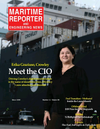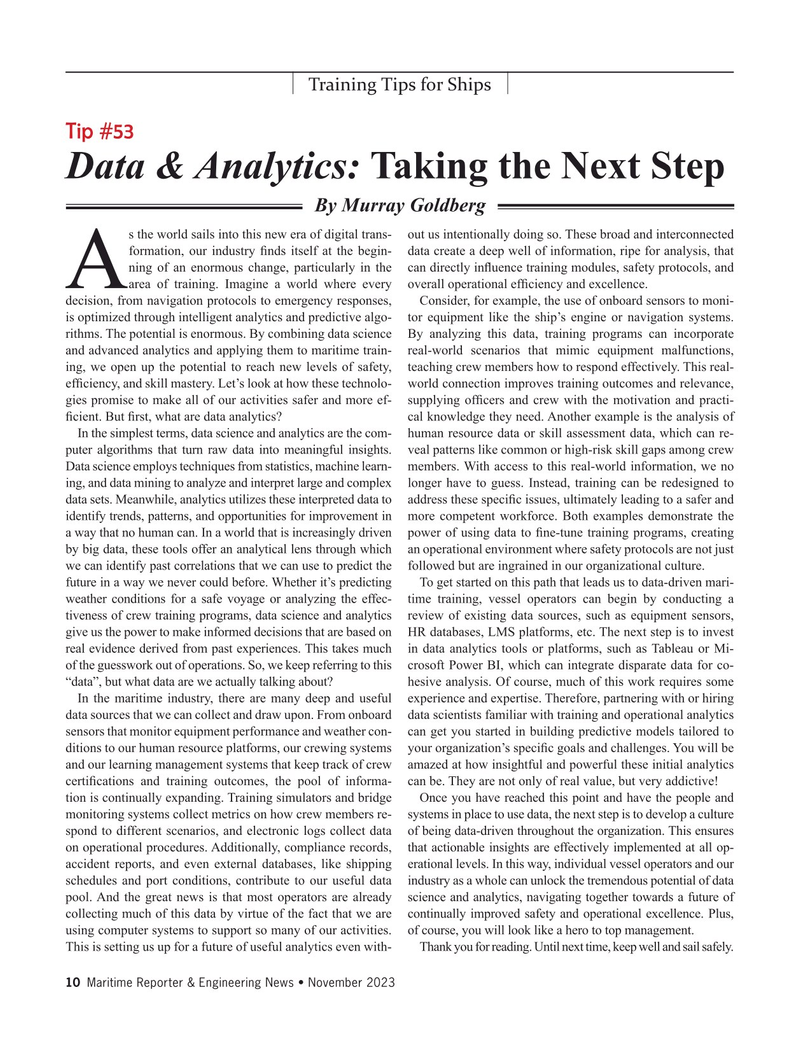
Page 10: of Maritime Reporter Magazine (November 2023)
Workboat Edition
Read this page in Pdf, Flash or Html5 edition of November 2023 Maritime Reporter Magazine
Training Tips for Ships
Tip #53
Data & Analytics: Taking the Next Step
By Murray Goldberg s the world sails into this new era of digital trans- out us intentionally doing so. These broad and interconnected formation, our industry ? nds itself at the begin- data create a deep well of information, ripe for analysis, that ning of an enormous change, particularly in the can directly in? uence training modules, safety protocols, and
Aarea of training. Imagine a world where every overall operational ef? ciency and excellence.
decision, from navigation protocols to emergency responses, Consider, for example, the use of onboard sensors to moni- is optimized through intelligent analytics and predictive algo- tor equipment like the ship’s engine or navigation systems. rithms. The potential is enormous. By combining data science By analyzing this data, training programs can incorporate and advanced analytics and applying them to maritime train- real-world scenarios that mimic equipment malfunctions, ing, we open up the potential to reach new levels of safety, teaching crew members how to respond effectively. This real- ef? ciency, and skill mastery. Let’s look at how these technolo- world connection improves training outcomes and relevance, gies promise to make all of our activities safer and more ef- supplying of? cers and crew with the motivation and practi- ? cient. But ? rst, what are data analytics? cal knowledge they need. Another example is the analysis of
In the simplest terms, data science and analytics are the com- human resource data or skill assessment data, which can re- puter algorithms that turn raw data into meaningful insights. veal patterns like common or high-risk skill gaps among crew
Data science employs techniques from statistics, machine learn- members. With access to this real-world information, we no ing, and data mining to analyze and interpret large and complex longer have to guess. Instead, training can be redesigned to data sets. Meanwhile, analytics utilizes these interpreted data to address these speci? c issues, ultimately leading to a safer and identify trends, patterns, and opportunities for improvement in more competent workforce. Both examples demonstrate the a way that no human can. In a world that is increasingly driven power of using data to ? ne-tune training programs, creating by big data, these tools offer an analytical lens through which an operational environment where safety protocols are not just we can identify past correlations that we can use to predict the followed but are ingrained in our organizational culture.
future in a way we never could before. Whether it’s predicting To get started on this path that leads us to data-driven mari- weather conditions for a safe voyage or analyzing the effec- time training, vessel operators can begin by conducting a tiveness of crew training programs, data science and analytics review of existing data sources, such as equipment sensors, give us the power to make informed decisions that are based on HR databases, LMS platforms, etc. The next step is to invest real evidence derived from past experiences. This takes much in data analytics tools or platforms, such as Tableau or Mi- of the guesswork out of operations. So, we keep referring to this crosoft Power BI, which can integrate disparate data for co- “data”, but what data are we actually talking about? hesive analysis. Of course, much of this work requires some
In the maritime industry, there are many deep and useful experience and expertise. Therefore, partnering with or hiring data sources that we can collect and draw upon. From onboard data scientists familiar with training and operational analytics sensors that monitor equipment performance and weather con- can get you started in building predictive models tailored to ditions to our human resource platforms, our crewing systems your organization’s speci? c goals and challenges. You will be and our learning management systems that keep track of crew amazed at how insightful and powerful these initial analytics certi? cations and training outcomes, the pool of informa- can be. They are not only of real value, but very addictive! tion is continually expanding. Training simulators and bridge Once you have reached this point and have the people and monitoring systems collect metrics on how crew members re- systems in place to use data, the next step is to develop a culture spond to different scenarios, and electronic logs collect data of being data-driven throughout the organization. This ensures on operational procedures. Additionally, compliance records, that actionable insights are effectively implemented at all op- accident reports, and even external databases, like shipping erational levels. In this way, individual vessel operators and our schedules and port conditions, contribute to our useful data industry as a whole can unlock the tremendous potential of data pool. And the great news is that most operators are already science and analytics, navigating together towards a future of collecting much of this data by virtue of the fact that we are continually improved safety and operational excellence. Plus, using computer systems to support so many of our activities. of course, you will look like a hero to top management.
This is setting us up for a future of useful analytics even with- Thank you for reading. Until next time, keep well and sail safely.
10 Maritime Reporter & Engineering News • November 2023
MR #11 (1-17).indd 10 11/2/2023 8:59:26 AM

 9
9

 11
11
